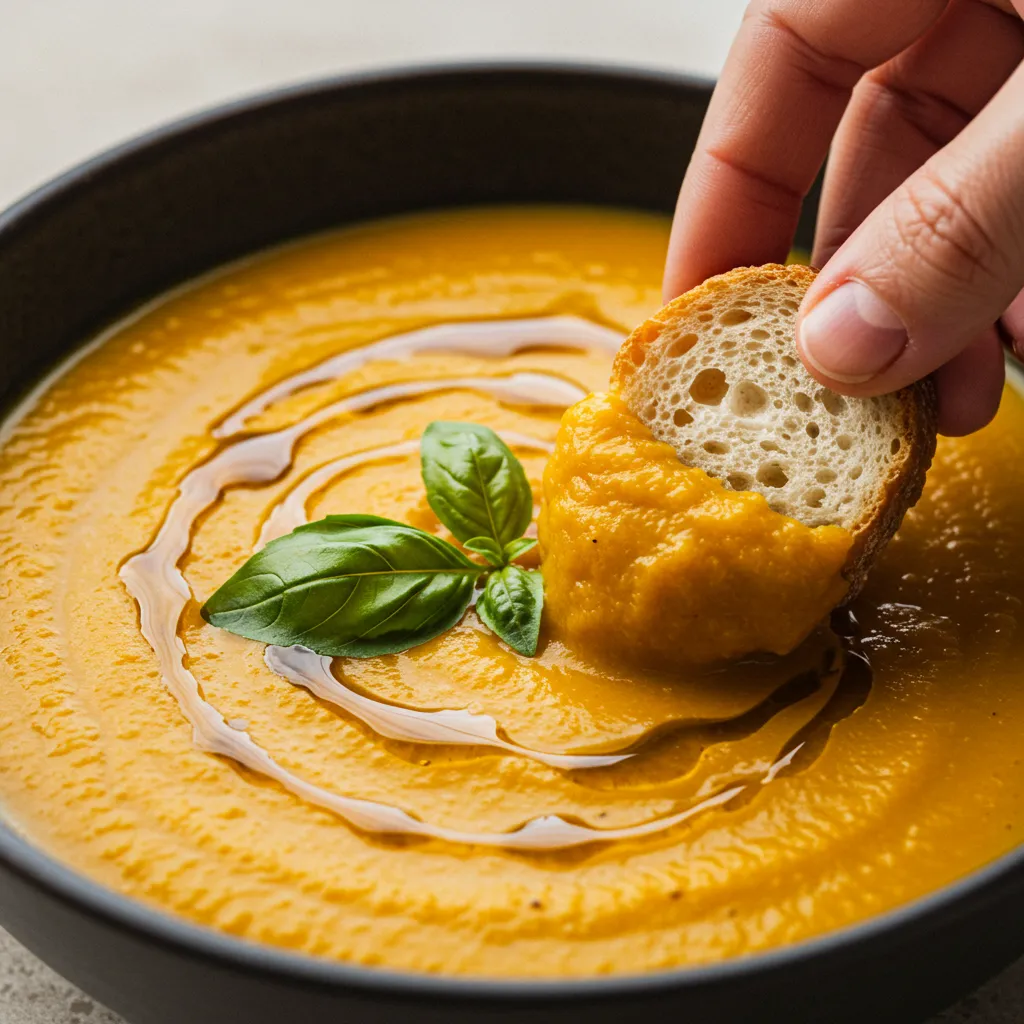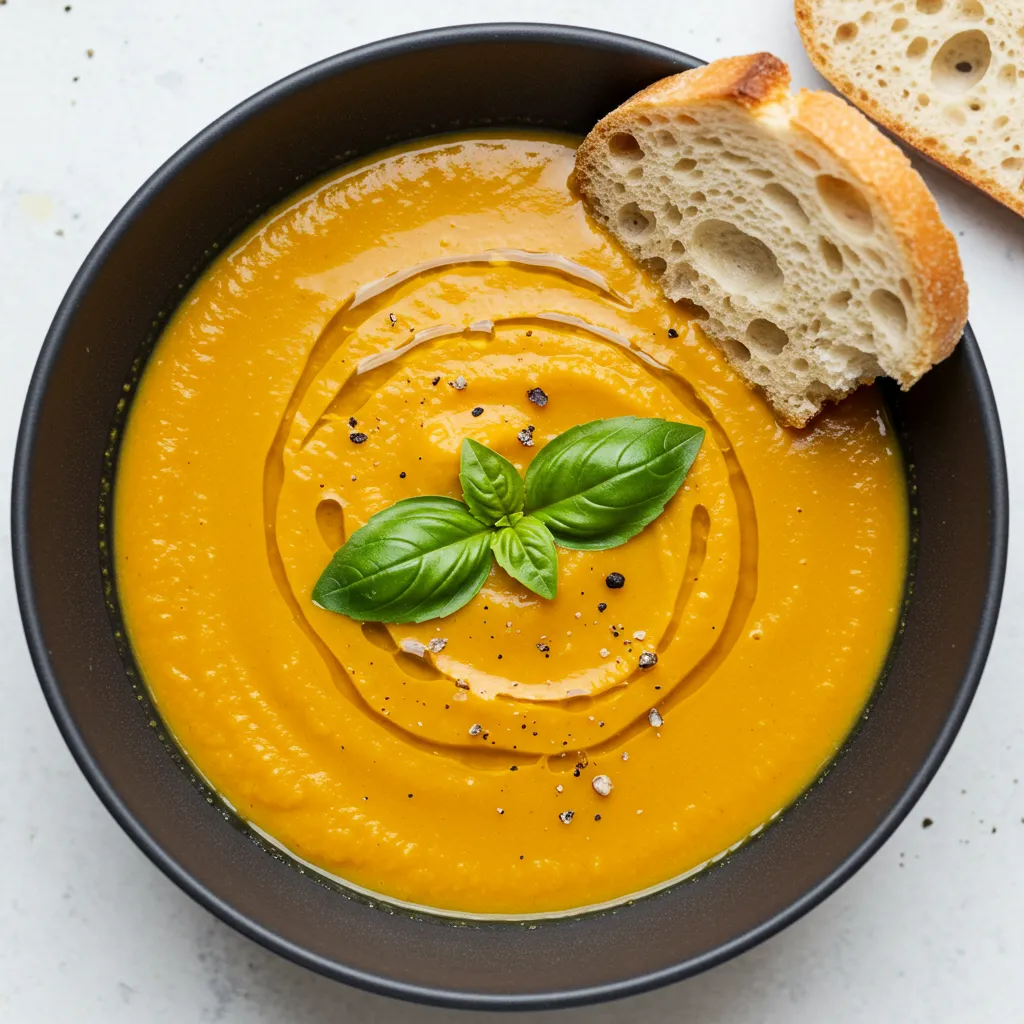This luxuriously smooth Roasted Vegetable Soup transforms humble vegetables into a velvety, flavor-packed bowl of comfort through the magic of roasting. The caramelization that occurs in the oven brings out the natural sweetness and depth of the vegetables, creating complex flavors with minimal effort. Completely vegan and gluten-free, this soup delivers a nourishing, hearty meal that’s perfect year-round and accommodates multiple dietary needs while sacrificing nothing in taste or satisfaction.
Why You’ll Love This Recipe
- Deep flavor complexity: Roasting concentrates and caramelizes the vegetables’ natural sugars
- Velvety texture: Blended to silky perfection without any dairy
- Dietary-friendly: Naturally vegan and gluten-free without special substitutions
- Versatile base: Easily customized with different vegetables or seasonings
- Make-ahead friendly: Tastes even better the next day
- Nutritional powerhouse: Packed with vitamins, minerals, and fiber
Ingredients
For Roasting
- Butternut squash – Provides sweet, nutty flavor and creamy texture
- Carrots – Add natural sweetness and vibrant color
- Sweet potatoes – Contribute velvety texture and earthy sweetness
- Red bell peppers – Offer fruity notes and beautiful color
- Onion – Creates savory depth and aromatic foundation
- Garlic – Adds essential aromatic complexity that mellows with roasting
- Olive oil – Facilitates caramelization and adds richness
- Fresh herbs – Infuse aromatic notes during roasting
For the Soup Base
- Vegetable broth – Forms the liquid foundation without animal products
- Tomato paste – Adds umami depth and rich color
- Spices – Enhance and balance the vegetable flavors
- Coconut milk – Creates creamy richness while keeping it vegan
- Lemon juice – Brightens and lifts all the flavors
- Salt and pepper – Essential for proper seasoning
For Garnish
- Fresh basil leaves – Add a pop of color and aromatic freshness
- Extra virgin olive oil – Provides a finishing richness
- Cracked black pepper – Offers visual contrast and gentle heat
- Toasted pumpkin seeds – Optional for textural contrast
Step-by-Step Instructions
Roasting the Vegetables
Begin by preheating your oven to 425°F (220°C). This high temperature is crucial for achieving proper caramelization, which is the foundation of this soup’s deep flavor. Line two large baking sheets with parchment paper for easy cleanup.
Prepare 1 medium butternut squash (about 2-3 pounds) by peeling, removing the seeds, and cutting into 1-inch cubes. The uniform size ensures even roasting. Next, peel and chop 4 large carrots and 2 medium sweet potatoes into similar-sized pieces. Seed and quarter 2 red bell peppers, and peel and quarter 1 large onion. Peel 1 whole head of garlic, leaving the cloves intact.
In a large mixing bowl, toss all the prepared vegetables with 3 tablespoons of olive oil, ensuring they’re well-coated but not drenched. Season generously with 1 teaspoon of salt and ½ teaspoon of freshly ground black pepper. Add 2 sprigs of fresh rosemary and 4 sprigs of fresh thyme for aromatic depth.
Spread the vegetables evenly across the prepared baking sheets, being careful not to overcrowd them. Overcrowding would cause the vegetables to steam rather than roast, preventing proper caramelization. If necessary, use a third baking sheet to ensure the vegetables have enough space.
Place the baking sheets in the preheated oven and roast for 35-40 minutes, rotating the pans halfway through and stirring the vegetables to ensure even browning. The vegetables are done when they’re tender when pierced with a fork and have developed caramelized edges with a deep golden color. This caramelization is what transforms ordinary vegetables into extraordinarily flavorful soup.
Creating the Soup Base
While the vegetables are roasting, prepare your soup base. In a large Dutch oven or heavy-bottomed pot, heat 1 tablespoon of olive oil over medium heat. Add 2 tablespoons of tomato paste and cook for about 1-2 minutes, stirring constantly. This “blooms” the tomato paste, developing its flavor and unlocking its umami potential.
Add 1 teaspoon of ground cumin, ½ teaspoon of ground coriander, and ¼ teaspoon of smoked paprika. Cook for another 30 seconds until fragrant, which allows the spices to bloom in the oil and develop their full aromatic potential. Pour in 4 cups of vegetable broth, stirring to incorporate the tomato paste and spices. Bring to a gentle simmer while you wait for the vegetables to finish roasting.
Combining and Blending
Once the vegetables have finished roasting, carefully transfer them to the pot with the broth, making sure to scrape any caramelized bits from the baking sheets – these contain concentrated flavor that will enrich your soup. Remove the herb sprigs at this point, as they’ve already imparted their flavor.
Simmer the vegetables and broth together for about 10 minutes to allow the flavors to meld. This brief simmering ensures that all the vegetables are completely tender and have absorbed some of the broth’s flavors.
Working in batches for safety, transfer the soup to a high-speed blender. Start on low speed and gradually increase to high, blending until completely smooth and velvety. Alternatively, use an immersion blender directly in the pot, though a countertop blender generally produces a smoother result. Blend until the soup has a silky consistency with no detectable vegetable pieces.
Return the blended soup to the pot over low heat. Stir in ½ cup of full-fat coconut milk, which adds luxurious creaminess while maintaining the soup’s vegan status. For a lighter version, you can use light coconut milk or even substitute with additional vegetable broth, though the texture won’t be quite as velvety.
Add 1 tablespoon of fresh lemon juice, which brightens all the flavors and balances the soup’s natural sweetness with a touch of acidity. Taste and adjust the seasoning with additional salt and pepper as needed. The soup should have a balance of sweet (from the roasted vegetables), savory (from the herbs and spices), and a hint of tangy brightness (from the lemon).
Serving Suggestions
Ladle the hot soup into warmed bowls. Drizzle each serving with a spiral of high-quality extra virgin olive oil, which adds a fruity richness and beautiful visual appeal. Place a fresh basil leaf in the center of each bowl – the aromatic oils released from the leaf add a wonderful fragrance to each spoonful.
Sprinkle with freshly cracked black pepper and, if desired, a few toasted pumpkin seeds for textural contrast. Serve with gluten-free crusty bread or seed crackers for dipping. The combination of the smooth soup with something to dip creates a satisfying textural experience.
This soup is best enjoyed hot, but it can also be served at room temperature during warmer months for a refreshing meal. The bright color and velvety texture make it as visually appealing as it is delicious.

Pro Tips
- For the deepest flavor, look for vegetables with visible caramelization, but not burning
- Use a high-powered blender for the silkiest texture
- When blending hot liquids, never fill blender more than halfway
- The soup will thicken as it cools – adjust consistency with additional broth if needed
- Roast extra vegetables to use in other dishes throughout the week
Variations and Creative Ideas
The beauty of this roasted vegetable soup lies in its adaptability. Consider these variations to suit different seasons, preferences, or what you have available:
Seasonal Adaptations
Autumn Harvest: Emphasize fall vegetables by using mostly butternut squash, adding a tart apple (cored and roasted alongside the vegetables), and finishing with a pinch of warming nutmeg and cinnamon.
Spring Renewal: Create a lighter version using roasted asparagus, leeks, and peas (add the peas after roasting). Garnish with fresh mint instead of basil and add a swirl of lemon-infused olive oil.
Summer Abundance: Incorporate roasted zucchini, yellow summer squash, and corn kernels (added in the last 15 minutes of roasting). Finish with fresh cherry tomatoes that have been quickly blistered under the broiler and a drizzle of basil oil.
Winter Comfort: Focus on root vegetables like parsnips, turnips, and rutabaga alongside the sweet potatoes. Add a tablespoon of white miso paste (ensuring it’s gluten-free if necessary) to the finished soup for added depth and umami.
Flavor Profiles
Curried Variation: Add 1 tablespoon of curry powder when blooming the spices. Use coconut milk as the creamy element and garnish with fresh cilantro and a dollop of dairy-free yogurt.
Mediterranean Inspired: Incorporate roasted eggplant and red onions. Blend in 2 tablespoons of tahini for creaminess, finish with za’atar spice blend, and serve with a dollop of dairy-free tzatziki.
Mexican Fusion: Add a roasted poblano pepper and substitute fire-roasted tomatoes for some of the broth. Season with ground cumin, coriander, and a pinch of chipotle powder. Garnish with diced avocado, lime juice, and fresh cilantro.
Thai Twist: Use lemongrass, galangal, and makrut lime leaves (removed before blending) during the simmering stage. Use full-fat coconut milk and finish with a squeeze of lime, a drizzle of chili oil, and fresh Thai basil.
Texture Variations
For those who prefer some texture in their soup:
Chunky Style: Reserve about a cup of the roasted vegetables before blending. After blending the remainder, add the reserved vegetables back in for a soup with distinct pieces throughout.
Garnish Extravaganza: Top the smooth soup with a tablespoon each of finely diced roasted vegetables, toasted nuts or seeds, and microgreens for a beautiful presentation with contrasting textures in each bite.
Grain Addition: Stir in 1/2 cup of cooked quinoa, wild rice, or buckwheat just before serving for a more substantial, meal-like soup with interesting texture.
Storage and Make-Ahead Advice
This Roasted Vegetable Soup is perfect for meal prep and actually improves in flavor after a day or two:
Refrigeration: Cool the soup completely before transferring to airtight containers. It will keep in the refrigerator for up to 5 days. The soup will thicken considerably when chilled, which is normal due to the starch content of the vegetables.
Freezing: This soup freezes beautifully for up to 3 months. For best results, freeze in individual portions in airtight containers, leaving about an inch of headspace to allow for expansion. Thaw overnight in the refrigerator before reheating.
Reheating: Warm the soup gently on the stovetop over medium-low heat, stirring occasionally. If the soup has thickened too much during storage, thin it with a little vegetable broth or water until it reaches your desired consistency. Alternatively, reheat in the microwave in 1-minute intervals at 70% power, stirring in between, until heated through.
Make-Ahead Strategy: For entertaining, make the soup up to 3 days in advance and refrigerate. On the day of serving, reheat gently and add any fresh garnishes just before serving. This approach allows the flavors to develop further while saving you time when it matters most.
Freezer Meal Prep: Double the recipe and freeze half in individual portions for quick lunches or dinners on busy days. Label containers with the date and contents for easy identification.
Nutritional Benefits
This Roasted Vegetable Soup is not only delicious but also packed with nutrition:
Antioxidant Rich: The bright orange and red vegetables contain beta-carotene and other carotenoids that support eye health and immune function.
Fiber Content: Each serving provides significant dietary fiber, supporting digestive health and promoting a feeling of fullness.
Heart Healthy: The combination of vegetables, olive oil, and absence of animal products makes this soup excellent for cardiovascular health.
Anti-Inflammatory: Many of the ingredients, particularly turmeric if added, have natural anti-inflammatory properties.
Immune Supporting: The high vitamin C content from the bell peppers and other vegetables helps support immune function.
For those tracking nutrition, each serving of this soup provides approximately 180-220 calories (depending on the exact vegetables used and amount of coconut milk), with healthy fats from the olive oil and coconut milk, complex carbohydrates from the vegetables, and a surprising amount of plant-based protein.
The soup is naturally low in sodium if you use low-sodium vegetable broth, making it appropriate for those monitoring their salt intake. The absence of common allergens like dairy, gluten, nuts (unless added as a garnish), and animal products makes it suitable for many with dietary restrictions or preferences.
Frequently Asked Questions
Can I use frozen vegetables instead of fresh? While fresh vegetables will give the best flavor through roasting, you can use frozen vegetables in a pinch. Thaw them completely, pat dry, and roast as directed, though they may not caramelize as well as fresh. The flavor will still be good, just slightly less intense.
My soup isn’t as smooth as I’d like. What can I do? If you want an ultra-silky texture, pass the blended soup through a fine-mesh strainer before adding the coconut milk. This removes any fibrous bits that might remain after blending.
How can I make this soup more filling for a main course? Add protein by topping with roasted chickpeas, stirring in white beans before blending (for creaminess while adding protein), or serving with a side of quinoa. Increasing the coconut milk or adding an avocado garnish adds healthy fats that increase satiety.
What can I substitute for coconut milk if I don’t like the flavor? If you’re still keeping it vegan, cashew cream works beautifully (blend 1/2 cup soaked raw cashews with 1/2 cup water until completely smooth). If vegan isn’t a requirement, you could use heavy cream or Greek yogurt.
Is there a low-carb version of this soup? Replace the sweet potatoes and some of the butternut squash with lower-carb vegetables like cauliflower, celeriac, or more bell peppers. The texture will be slightly different but still delicious, and the carb count will be significantly lower.

Ingredients
- 1 medium butternut squash (about 2-3 pounds), peeled, seeded, and cubed
- 4 large carrots, peeled and chopped
- 2 medium sweet potatoes, peeled and cubed
- 2 red bell peppers, seeded and quartered
- 1 large onion, peeled and quartered
- 1 head of garlic, cloves peeled
- 3 tablespoons olive oil, plus more for drizzling
- 2 sprigs fresh rosemary
- 4 sprigs fresh thyme
- 1 teaspoon salt, plus more to taste
- 1/2 teaspoon freshly ground black pepper, plus more to taste
- 2 tablespoons tomato paste
- 1 teaspoon ground cumin
- 1/2 teaspoon ground coriander
- 1/4 teaspoon smoked paprika
- 4 cups vegetable broth
- 1/2 cup full-fat coconut milk
- 1 tablespoon fresh lemon juice
- Fresh basil leaves, for garnish
- Extra virgin olive oil, for serving
- Toasted pumpkin seeds, for garnish (optional)
Instructions
- Preheat oven to 425°F (220°C) and line two baking sheets with parchment paper.
- Prepare vegetables: peel and cube butternut squash, sweet potatoes, and carrots into 1-inch pieces. Quarter bell peppers and onion. Keep garlic cloves whole.
- Toss vegetables with 3 tablespoons olive oil, salt, pepper, rosemary, and thyme. Spread evenly on baking sheets, ensuring they're not overcrowded.
- Roast vegetables for 35-40 minutes, rotating pans halfway through, until tender and caramelized.
- Meanwhile, in a large pot, heat 1 tablespoon olive oil over medium heat. Add tomato paste and cook for 1-2 minutes, stirring constantly.
- Add cumin, coriander, and smoked paprika, cooking for 30 seconds until fragrant.
- Pour in vegetable broth, stirring to incorporate the tomato paste and spices. Bring to a simmer.
- When vegetables are done roasting, transfer them to the pot, removing herb sprigs. Simmer for 10 minutes.
- Blend soup until completely smooth using a high-speed blender (in batches) or an immersion blender.
- Return soup to pot over low heat. Stir in coconut milk and lemon juice.
- Taste and adjust seasoning with additional salt and pepper as needed.
- Serve hot, garnished with a drizzle of extra virgin olive oil, fresh basil leaves, cracked black pepper, and toasted pumpkin seeds if desired.
Notes
- If you don't have fresh herbs, use 1 teaspoon dried rosemary and 1 teaspoon dried thyme
- For extra depth of flavor, add a splash of balsamic vinegar when roasting the vegetables
- The soup will thicken as it cools; thin with additional broth if needed when reheating
- For a little heat, add a pinch of cayenne pepper or red pepper flakes
- If your blender isn't high-powered, strain the soup through a fine-mesh sieve after blending for the silkiest texture

